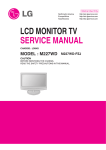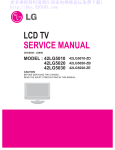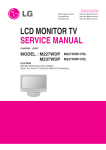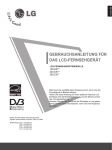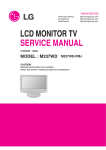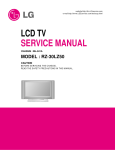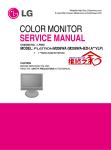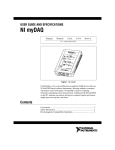Download LCD TV SERVICE MANUAL
Transcript
Internal Use Only website:http://biz.LGservice.com LCD TV SERVICE MANUAL CHASSIS : LD84A MODEL : 32LG5000 MODEL : 32LG5010 MODEL : 32LG5020 MODEL : 32LG5030 32LG5000-ZA 32LG5010-ZD 32LG5020-ZB 32LG5030-ZE CAUTION BEFORE SERVICING THE CHASSIS, READ THE SAFETY PRECAUTIONS IN THIS MANUAL. CONTENTS CONTENTS .............................................................................................. 2 PRODUCT SAFETY ..................................................................................3 SPECIFICATION ........................................................................................6 ADJUSTMENT INSTRUCTION ...............................................................10 TROUBLE SHOOTING ............................................................................14 BLOCK DIAGRAM...................................................................................20 EXPLODED VIEW .................................................................................. 22 SVC. SHEET ............................................................................................... Copyright © 2008 LG Electronics. Inc. All right reserved. Only for training and service purposes -2- LGE Internal Use Only SAFETY PRECAUTIONS IMPORTANT SAFETY NOTICE Many electrical and mechanical parts in this chassis have special safety-related characteristics. These parts are identified by in the Schematic Diagram and Replacement Parts List. It is essential that these special safety parts should be replaced with the same components as recommended in this manual to prevent Shock, Fire, or other Hazards. Do not modify the original design without permission of manufacturer. Leakage Current Hot Check (See below Figure) Plug the AC cord directly into the AC outlet. General Guidance An isolation Transformer should always be used during the servicing of a receiver whose chassis is not isolated from the AC power line. Use a transformer of adequate power rating as this protects the technician from accidents resulting in personal injury from electrical shocks. It will also protect the receiver and it's components from being damaged by accidental shorts of the circuitry that may be inadvertently introduced during the service operation. If any fuse (or Fusible Resistor) in this TV receiver is blown, replace it with the specified. When replacing a high wattage resistor (Oxide Metal Film Resistor, over 1W), keep the resistor 10mm away from PCB. Do not use a line Isolation Transformer during this check. Connect 1.5K/10watt resistor in parallel with a 0.15uF capacitor between a known good earth ground (Water Pipe, Conduit, etc.) and the exposed metallic parts. Measure the AC voltage across the resistor using AC voltmeter with 1000 ohms/volt or more sensitivity. Reverse plug the AC cord into the AC outlet and repeat AC voltage measurements for each exposed metallic part. Any voltage measured must not exceed 0.75 volt RMS which is corresponds to 0.5mA. In case any measurement is out of the limits specified, there is possibility of shock hazard and the set must be checked and repaired before it is returned to the customer. Leakage Current Hot Check circuit Keep wires away from high voltage or high temperature parts. AC Volt-meter Before returning the receiver to the customer, always perform an AC leakage current check on the exposed metallic parts of the cabinet, such as antennas, terminals, etc., to be sure the set is safe to operate without damage of electrical shock. Leakage Current Cold Check(Antenna Cold Check) With the instrument AC plug removed from AC source, connect an electrical jumper across the two AC plug prongs. Place the AC switch in the on position, connect one lead of ohm-meter to the AC plug prongs tied together and touch other ohm-meter lead in turn to each exposed metallic parts such as antenna terminals, phone jacks, etc. If the exposed metallic part has a return path to the chassis, the measured resistance should be between 1MΩ and 5.2MΩ. When the exposed metal has no return path to the chassis the reading must be infinite. An other abnormality exists that must be corrected before the receiver is returned to the customer. Copyright © 2008 LG Electronics. Inc. All right reserved. Only for training and service purposes -3- To Instrument's exposed METALLIC PARTS 0.15uF Good Earth Ground such as WATER PIPE, CONDUIT etc. 1.5 Kohm/10W LGE Internal Use Only SERVICING PRECAUTIONS CAUTION: Before servicing receivers covered by this service manual and its supplements and addenda, read and follow the SAFETY PRECAUTIONS on page 3 of this publication. NOTE: If unforeseen circumstances create conflict between the following servicing precautions and any of the safety precautions on page 3 of this publication, always follow the safety precautions. Remember: Safety First. General Servicing Precautions 1. Always unplug the receiver AC power cord from the AC power source before; a. Removing or reinstalling any component, circuit board module or any other receiver assembly. b. Disconnecting or reconnecting any receiver electrical plug or other electrical connection. c. Connecting a test substitute in parallel with an electrolytic capacitor in the receiver. CAUTION: A wrong part substitution or incorrect polarity installation of electrolytic capacitors may result in an explosion hazard. 2. Test high voltage only by measuring it with an appropriate high voltage meter or other voltage measuring device (DVM, FETVOM, etc) equipped with a suitable high voltage probe. Do not test high voltage by "drawing an arc". 3. Do not spray chemicals on or near this receiver or any of its assemblies. 4. Unless specified otherwise in this service manual, clean electrical contacts only by applying the following mixture to the contacts with a pipe cleaner, cotton-tipped stick or comparable non-abrasive applicator; 10% (by volume) Acetone and 90% (by volume) isopropyl alcohol (90%-99% strength) CAUTION: This is a flammable mixture. Unless specified otherwise in this service manual, lubrication of contacts in not required. 5. Do not defeat any plug/socket B+ voltage interlocks with which receivers covered by this service manual might be equipped. 6. Do not apply AC power to this instrument and/or any of its electrical assemblies unless all solid-state device heat sinks are correctly installed. 7. Always connect the test receiver ground lead to the receiver chassis ground before connecting the test receiver positive lead. Always remove the test receiver ground lead last. 8. Use with this receiver only the test fixtures specified in this service manual. CAUTION: Do not connect the test fixture ground strap to any heat sink in this receiver. Electrostatically Sensitive (ES) Devices Some semiconductor (solid-state) devices can be damaged easily by static electricity. Such components commonly are called Electrostatically Sensitive (ES) Devices. Examples of typical ES devices are integrated circuits and some field-effect transistors and semiconductor "chip" components. The following techniques should be used to help reduce the incidence of component damage caused by static by static electricity. 1. Immediately before handling any semiconductor component or semiconductor-equipped assembly, drain off any electrostatic charge on your body by touching a known earth ground. Alternatively, obtain and wear a commercially available discharging wrist strap device, which should be removed to prevent potential shock reasons prior to applying power to the Copyright © 2008 LG Electronics. Inc. All right reserved. Only for training and service purposes unit under test. 2. After removing an electrical assembly equipped with ES devices, place the assembly on a conductive surface such as aluminum foil, to prevent electrostatic charge buildup or exposure of the assembly. 3. Use only a grounded-tip soldering iron to solder or unsolder ES devices. 4. Use only an anti-static type solder removal device. Some solder removal devices not classified as "anti-static" can generate electrical charges sufficient to damage ES devices. 5. Do not use freon-propelled chemicals. These can generate electrical charges sufficient to damage ES devices. 6. Do not remove a replacement ES device from its protective package until immediately before you are ready to install it. (Most replacement ES devices are packaged with leads electrically shorted together by conductive foam, aluminum foil or comparable conductive material). 7. Immediately before removing the protective material from the leads of a replacement ES device, touch the protective material to the chassis or circuit assembly into which the device will be installed. CAUTION: Be sure no power is applied to the chassis or circuit, and observe all other safety precautions. 8. Minimize bodily motions when handling unpackaged replacement ES devices. (Otherwise harmless motion such as the brushing together of your clothes fabric or the lifting of your foot from a carpeted floor can generate static electricity sufficient to damage an ES device.) General Soldering Guidelines 1. Use a grounded-tip, low-wattage soldering iron and appropriate tip size and shape that will maintain tip temperature within the range or 500°F to 600°F. 2. Use an appropriate gauge of RMA resin-core solder composed of 60 parts tin/40 parts lead. 3. Keep the soldering iron tip clean and well tinned. 4. Thoroughly clean the surfaces to be soldered. Use a mall wirebristle (0.5 inch, or 1.25cm) brush with a metal handle. Do not use freon-propelled spray-on cleaners. 5. Use the following unsoldering technique a. Allow the soldering iron tip to reach normal temperature. (500°F to 600°F) b. Heat the component lead until the solder melts. c. Quickly draw the melted solder with an anti-static, suctiontype solder removal device or with solder braid. CAUTION: Work quickly to avoid overheating the circuit board printed foil. 6. Use the following soldering technique. a. Allow the soldering iron tip to reach a normal temperature (500°F to 600°F) b. First, hold the soldering iron tip and solder the strand against the component lead until the solder melts. c. Quickly move the soldering iron tip to the junction of the component lead and the printed circuit foil, and hold it there only until the solder flows onto and around both the component lead and the foil. CAUTION: Work quickly to avoid overheating the circuit board printed foil. d. Closely inspect the solder area and remove any excess or splashed solder with a small wire-bristle brush. -4- LGE Internal Use Only IC Remove/Replacement Some chassis circuit boards have slotted holes (oblong) through which the IC leads are inserted and then bent flat against the circuit foil. When holes are the slotted type, the following technique should be used to remove and replace the IC. When working with boards using the familiar round hole, use the standard technique as outlined in paragraphs 5 and 6 above. Removal 1. Desolder and straighten each IC lead in one operation by gently prying up on the lead with the soldering iron tip as the solder melts. 2. Draw away the melted solder with an anti-static suction-type solder removal device (or with solder braid) before removing the IC. Replacement 1. Carefully insert the replacement IC in the circuit board. 2. Carefully bend each IC lead against the circuit foil pad and solder it. 3. Clean the soldered areas with a small wire-bristle brush. (It is not necessary to reapply acrylic coating to the areas). "Small-Signal" Discrete Transistor Removal/Replacement 1. Remove the defective transistor by clipping its leads as close as possible to the component body. 2. Bend into a "U" shape the end of each of three leads remaining on the circuit board. 3. Bend into a "U" shape the replacement transistor leads. 4. Connect the replacement transistor leads to the corresponding leads extending from the circuit board and crimp the "U" with long nose pliers to insure metal to metal contact then solder each connection. Power Output, Transistor Device Removal/Replacement 1. Heat and remove all solder from around the transistor leads. 2. Remove the heat sink mounting screw (if so equipped). 3. Carefully remove the transistor from the heat sink of the circuit board. 4. Insert new transistor in the circuit board. 5. Solder each transistor lead, and clip off excess lead. 6. Replace heat sink. Circuit Board Foil Repair Excessive heat applied to the copper foil of any printed circuit board will weaken the adhesive that bonds the foil to the circuit board causing the foil to separate from or "lift-off" the board. The following guidelines and procedures should be followed whenever this condition is encountered. At IC Connections To repair a defective copper pattern at IC connections use the following procedure to install a jumper wire on the copper pattern side of the circuit board. (Use this technique only on IC connections). 1. Carefully remove the damaged copper pattern with a sharp knife. (Remove only as much copper as absolutely necessary). 2. carefully scratch away the solder resist and acrylic coating (if used) from the end of the remaining copper pattern. 3. Bend a small "U" in one end of a small gauge jumper wire and carefully crimp it around the IC pin. Solder the IC connection. 4. Route the jumper wire along the path of the out-away copper pattern and let it overlap the previously scraped end of the good copper pattern. Solder the overlapped area and clip off any excess jumper wire. At Other Connections Use the following technique to repair the defective copper pattern at connections other than IC Pins. This technique involves the installation of a jumper wire on the component side of the circuit board. 1. Remove the defective copper pattern with a sharp knife. Remove at least 1/4 inch of copper, to ensure that a hazardous condition will not exist if the jumper wire opens. 2. Trace along the copper pattern from both sides of the pattern break and locate the nearest component that is directly connected to the affected copper pattern. 3. Connect insulated 20-gauge jumper wire from the lead of the nearest component on one side of the pattern break to the lead of the nearest component on the other side. Carefully crimp and solder the connections. CAUTION: Be sure the insulated jumper wire is dressed so the it does not touch components or sharp edges. Diode Removal/Replacement 1. Remove defective diode by clipping its leads as close as possible to diode body. 2. Bend the two remaining leads perpendicular y to the circuit board. 3. Observing diode polarity, wrap each lead of the new diode around the corresponding lead on the circuit board. 4. Securely crimp each connection and solder it. 5. Inspect (on the circuit board copper side) the solder joints of the two "original" leads. If they are not shiny, reheat them and if necessary, apply additional solder. Fuse and Conventional Resistor Removal/Replacement 1. Clip each fuse or resistor lead at top of the circuit board hollow stake. 2. Securely crimp the leads of replacement component around notch at stake top. 3. Solder the connections. CAUTION: Maintain original spacing between the replaced component and adjacent components and the circuit board to prevent excessive component temperatures. Copyright © 2008 LG Electronics. Inc. All right reserved. Only for training and service purposes -5- LGE Internal Use Only SPECIFICATION NOTE : Specifications and others are subject to change without notice for improvement. 1. Application range 3. Test method This specification is applied to the LCD TV used LD84A chassis. 2. Requirement for Test 1) Performance: LGE TV test method followed 2) Demanded other specification - Safety: CE, IEC specification - EMC: CE, IEC Model Each part is tested as below without special appointment. 32LG5000-ZA Market EU(PAL market) 1) Temperature : 25±5ºC (77±9ºF), CST : 40±5ºC 2) Relative Humidity : 65±10% 3) Power Voltage : Standard input voltage(100-240V~, 50/60Hz) * Standard Voltage of each products is marked by models. 4) Specification and performance of each parts are followed each drawing and specification by part number in accordance with BOM. 5) The receiver must be operated for about 20 minutes prior to the adjustment. Appliance Safety : IEC/EN60065 EMI : EN55013 EMS : EN55020 4. Module general specification Item Specification Display Screen Device 32” wide Color Display Module Aspect Ratio 16:9 LCD Module 32” TFT LCD HD Remark LCD LG5000 MAKER : 32”- CMO Operating Environment Temp. : 0 ~ 40 deg LGE SPEC Humidity : 0 ~ 85% Storage Environment Temp. : -20 ~ 60 deg Humidity : 0 ~ 85 % Input Voltage 100 - 240V~, 50/60Hz Power Consumption Power on (Green) 32” ≤ 130W (10.08 + 120 W) LG5000 LCD + Backlight Type Size 32” 760(H) x 450(V) x 47.4(D) LG5000 With inverter Pixel Pitch 32” 0.17025(H) x 0.51075 (V) LG5000 Back Light 32” 16CCFL, Straight type LG5000 Display Colors 16.7M (16,777,216) Coating 3H, AG Copyright © 2008 LG Electronics. Inc. All right reserved. Only for training and service purposes -6- LGE Internal Use Only 5. Model general specification Item Market Specification Remark EU (PAL Market-26 Countries) DTV & Analog UK, France, Germany, Spain, Sweden, Finland, Italy, Netherland, Belgium, Luxemburg, Greece, Denmark, Czech, Austria, Hngary, Switzerland, Croatia, Turkey Analog Only Poland, Portugal, Norway, Bulgaria, Serbia, Slovenia, Russia, Romania Broadcasting system PAL-BG PAL-DK PAL-I/I’ SECAM L/L’ DVB-T(ID TV) Receiving system Analog : Upper Heterodyne Digital : COFDM Scart Jack (2EA) PAL, SECAM Scart 1 Jack is Full scart and support RF-OUT(analog). Scart 2 Jack is Half scart and support MNT/DTV-OUT. Video Input RCA(1EA) PAL, SECAM, NTSC 4 System : PAL, SECAM, NTSC, PAL60 S-Video Input (1EA) PAL, SECAM, NTSC 4 System : PAL, SECAM, NTSC, PAL60 Component Input(1EA) Y/Cb/Cr Y/ Pb/Pr RGB Input(1EA) RGB-PC Analog (D-SUB 15PIN) HDMI Input(3EA) HDMI1-DTV/DVI PC(HDMI version 1.3) HDMI2-DTV Support HDCP HDMI3-DTV Audio Input(3EA) RGB/DVI Audio L/R Input Component AV SPDIF out(1EA) SPDIF out Earphone (1EA) Antenna, AV1, AV2, AV3, Component, RGB, HDMI1, HDMI2, HDMI USB (1EA) Copyright © 2008 LG Electronics. Inc. All right reserved. Only for training and service purposes For service only -7- LGE Internal Use Only 6. Component Video Input (Y, PB, PR) No Specification Remark Resolution H-freq(kHz) V-freq(Hz) 1 720*480 15.73 60.00 SDTV, DVD 480i 2 720*480 15.63 59.94 SDTV, DVD 480i 3 720*480 31.47 59.94 480p 4 720*480 31.50 60.00 480p 5 720*576 15.625 50.00 SDTV, DVD 625 Line 6 720*576 31.25 50.00 HDTV 576p 7 1280*720 45.00 50.00 HDTV 720p 8 1280*720 44.96 59.94 HDTV 720p 9 1280*720 45.00 60.00 HDTV 720p 10 1920*1080 31.25 50.00 HDTV 1080i 11 1920*1080 33.75 60.00 HDTV 1080i 12 1920*1080 33.72 59.94 HDTV 1080i 13 1920*1080 26.97/27 23.97/24 HDTV 1080p 14 1920*1080 33.716/33.75 29.976/30.00 HDTV 1080p 15 1920*1080 56.250 50 HDTV 1080p 16 1920*1080 67.43/67.5 59.94/60 HDTV 1080p 7. RGB PC INPUT Mode No V-freq.(Hz) Pixel clock(MHz) 1 720*400 Resolution H-freq(kHz) 31.468 70.08 28.321 Proposed 2 640*480 31.469 59.94 25.17 37.684 75.00 31.50 3 800*600 37.879 60.31 40.00 46.875 75.00 49.50 4 832*624 49.725 74.55 57.283 Macintosh 5 1024*768 48.363 60.00 65.00 VESA(XGA) 56.470 70.00 75.00 VESA Input 848*480 60Hz, 852*480 60Hz -> 640*480 60Hz Display VESA 60.123 75.029 78.75 6 1280*768 47.78 59.87 79.5 WXGA 7 1360*768 47.72 59.8 84.75 WXGA 8 1366*768 47.56 59.6 84.75 WXGA 9 1440*900 55.5 59.90 88.750 WXGA 19LG3000-ZA only 10 1400*1050 64.744 59.948 101.00 WSXGA 22LG3000-ZA only 11 1680*1050 65.16 59.94 147.00 WSXGA 22LG3000-ZA only 12 1280*1024 63.595 60.0 108.875 SXGA FHD Model only 13 1920*1080 66.647 59.988 138.625 WUXGA FHD Model only Copyright © 2008 LG Electronics. Inc. All right reserved. Only for training and service purposes -8- LGE Internal Use Only 8. HDMI DTV No Resolution H-freq(kHz) V-freq.(Hz) Pixel clock(MHz) Proposed 1 720*480 15.734 / 15.6 59.94 / 60 27.00 SDTV 480I 2 720*480 31.469 / 31.5 59.94 / 60 27.00/27.03 SDTV 480P 3 720*576 15.625 50 27(54) SDTV 576I 4 720*576 31.25 50 54 SDTV 576P 5 1280*720 37.500 50 74.25 HDTV 720P 6 1280*720 44.96 / 45 59.94 / 60 74.17/74.25 HDTV 720P 7 1920*1080 33.72 / 33.75 59.94 / 60 74.17/74.25 HDTV 1080I 8 1920*1080 28.125 50.00 74.25 HDTV 1080I 9 1920*1080 26.97 / 27 23.97 / 24 74.17/74.25 HDTV 1080P 10 1920*1080 33.716 / 33.75 29.976 / 30.00 74.25 HDTV 1080P 11 1920*1080 56.250 50 148.5 HDTV 1080P 12 1920*1080 67.43 / 67.5 59.94 / 60 148.35/148.50 HDTV 1080P 9. HDMI PC No Resolution H-freq(kHz) V-freq.(Hz) Pixel clock(MHz) Proposed Remark 1 720*400 31.468 70.08 28.321 HDCP 2 640*480 31.469 59.94 25.17 VESA HDCP 37.684 75.00 31.50 37.879 60.31 40.00 VESA HDCP 46.875 75.00 49.50 3 800*600 4 832*624 49.725 74.55 57.283 Macintosh HDCP 5 1024*768 48.363 60.00 65.00 VESA(XGA) HDCP 56.470 70.00 75.00 60.123 75.029 78.75 6 1280*768 47.78 59.87 79.5 WXGA HDCP 7 1360*768 47.72 59.8 84.75 WXGA HDCP 8 1366*768 47.56 59.6 84.75 WXGA HDCP 9 1440*900 55.5 59.90 88.750 WXGA 19LG3000-ZA only 10 1400*1050 64.744 59.948 101.00 WSXGA 22LG3000-ZA only 11 1680*1050 65.16 59.94 147.00 WSXGA 22LG3000-ZA only 12 1280*1024 63.595 60.0 108.875 SXGA FHD Model only, HDCP 13 1920*1080 66.647 59.988 138.625 WUXGA FHD Model only, HDCP Copyright © 2008 LG Electronics. Inc. All right reserved. Only for training and service purposes -9- LGE Internal Use Only ADJUSTMENT INSTRUCTION 5. Click “Auto” tab and set as below 6. Click “Run”. 7. After downloading, check “OK” message. 1. Application Range This specification sheet is applied to all of the LCD TV with LD84A chassis. (5) filexxx.bin 2. Designation (7) ........ OK 1) The adjustment is according to the order which is designated and which must be followed, according to the plan which can be changed only on agreeing. 2) Power Adjustment: Free Voltage 3) Magnetic Field Condition: Nil. 4) Input signal Unit: Product Specification Standard 5) Reserve after operation: Above 5 Minutes (Heat Run) Temperature : at 25±5ºC Relative humidity : 65±10% Input voltage : 220V, 60Hz 6) Adjustment equipments: Color Analyzer (CA-210 or CA110), Pattern Generator (MSPG-925L or Equivalent), DDC Adjustment Jig equipment, SVC remote controller 7) Don’t push The “IN STOP KEY” after completing the function inspection. (6) * USB DOWNLOAD 1) Put the USB Stick to the USB socket 2) Automatically detecting update file in USB Stick - If your downloaded program version in USB Stick is Low, it didn’t work. But your downloaded version is High, USB data is automatically detecting 3) Show the message “Copying files from memory” 3. Main PCB check process * APC - After Manual-Insult, executing APC * Download 1) Execute ISP program “Mstar ISP Utility” and then click “Config” tab. 2) Set as below, and then click “Auto Detect” and check “OK” message. If display “Error”, Check connect computer, jig, and set. 3) Click “Connect” tab. If display “Can’t”, Check connect computer, jig, and set. (1) 4) Updating is staring. (3) Please Check Speed : To us speed between from 200 KHz to 400 KHz (2) OK 4) Click “Read” tab, and then load download file(XXXX.bin) by clicking “Read”. (4) filexxx.bin Copyright © 2008 LG Electronics. Inc. All right reserved. Only for training and service purposes - 10 - 5) Updating Completed, The TV will restart automatically. 6) If your TV is turned on, check your updated version and Tool option. (explain the Tool option, next stage) * If downloading version is more high than your TV have, TV can lost all channel data. In this case, you have to channel recover. if all channel data is cleared, you didn’t have a DTV/ATV test on production line. LGE Internal Use Only Impress Resolution 1080i Model : 223 in Pattern Generator(1080i Mode) Pattern: 65 in Pattern Generator(MSPG-925 series) * After downloading, have to adjust TOOL OPTION again. 1) Push "IN-START" key in service remote controller 2) Select "Tool Option 1" and Punch in the number.(Each model has their number.) 32LG5000-ZA : 8977 3) Completed selecting Tool option 3.1. ADC Process (1) PC input ADC 1) Auto RGB Gain/Offset Adjustment - Convert to PC in Input-source - Signal equipment displays Output Voltage : 700 mVp-p Impress Resolution XGA (1024 x 768 @ 60Hz) Model : 60 in Pattern Generator Pattern : 65 in Pattern Generator (MSPG-925 Series) <Fig. 2> Adjustment pattern(COMPONENT) - Adjust by commanding AUTO_COLOR_ADJUST. 2) Confirmation - We confirm whether “0xB3 (480i)/0xBC (1080i)” address of EEPROM “0xA2” is “0xAA” or not. - If “0xB3 (480i)/0xBC(1080i)” address of EEPROM “0xA2” isn’t “0xAA”, we adjust once more. - We can confirm the ADC values from “0xAD~0XB2 (480i)/0XB6~BB (1080i)” addresses in a page “0xA2”. * Manual ADC process using Service Remocon. After enter Service Mode by pushing “ADJ” key, execute “ADC Adjust” by pushing “ G ” key at “ADC CALIBRATION :COMPONENT”. <Fig. 1> Adjustment pattern(PC) Impress Resolution 480i - Adjust by commanding AUTO_COLOR_ADJUST. 2) Confirmation - We confirm whether “0xAA (RGB)” address of EEPROM “0xA2” is “0xAA” or not. - If “0xAA (RGB)” address of EEPROM “0xA2” isn’t “0xAA”, we adjust once more - We can confirm the ADC values from “0xA4~0XA9 (RGB)” addresses in a page “0xA2” * Manual ADC process using Service Remocon. After enter Service Mode by pushing “ADJ” key, execute “ADC Adjust” by pushing “ G ” key at “ADC CALIBRATION: RGB-PC”. (2) COMPONENT input ADC 1) Component Gain/Offset Adjustment - Convert to Component in Input-source - Signal equipment displays Impress Resolution 480i MODEL : 209 in Pattern Generator(480i Mode) Pattern : 65 in Pattern Generator (MSPG-925 series) Copyright © 2008 LG Electronics. Inc. All right reserved. Only for training and service purposes Impress Resolution 1080i 3.2. Function Check - 11 - (1) Check display and sound - Check Input and Signal items. (cf. work instructions) 1) TV 2) AV (SCART1/SCART2/S-VHS/CVBS) 3) COMPONENT (480i) 4) RGB (PC : 1024 x 768 @ 60hz) 5) HDMI 6) PC Audio In * Display and Sound check is executed by Remote controller. LGE Internal Use Only 4.3 DDC EDID Write (RGB 128Byte ) 4. Total Assembly line process - Connect D-sub Signal Cable to D-Sub Jack. - Write EDID DATA to EEPROM (24C02) by using DDC2B protocol. - Check whether written EDID data is correct or not. 4.1. Adjustment Preparation (1) W/B Equipment condition CA210: CH 9, Test signal: Inner pattern (85IRE) (2) Above 5 minutes H/run in the inner pattern. (“power on” key of adjust remote control) (3) 15 Pin D-Sub Jack is connected to the AUTO W/B EQUIPMENT. (4) Adjust Process will start by execute I2C Command (Inner pattern (0xF3, 0xFF). Color Cool 11,000 Temperature ºK X=0.276(±0.002) Y=0.283(±0.002) Medium 9,300 ºK X=0.285(±0.002) Warm ºK X=0.313(±0.002) - Connect HDMI Signal Cable to HDMI Jack. - Write EDID DATA to EEPROM(24C02) by using DDC2B protocol. - Check whether written EDID data is correct or not. <Test Signal> Inner patern (216gray,85IRE) 4.5 Serial number (RS-232C) Y=0.293(±0.002) 6,500 4.4. DDC EDID Write (HDMI 256Byte) - Press “Power on” key of service remocon. (Baud rate : 115200 bps) - Connect RS232 Signal Cable to RS-232 Jack. - Write Serial number by use RS-232. - Must check the serial number at the Diagnostics of SET UP menu. (Refer to below). Y=0.329(±0.002) (5) Adjust Process will finish by execute I2C Command (Inner pattern (Inner pattern (0xF3,0x00)). ** Caution ** Color Temperature: COOL, Medium, Warm One of R Gain/G Gain/ B Gain should be kept on 0xC0, and adjust other two lower than C0. (when R/G/B Gain are all C0, it is the FULL Dynamic Range of Module) * Manual W/B process using adjusts Remote control. After enter Service Mode by pushing “ADJ” key, Enter White Pattern off of service mode, and change off -> on. Enter “W/B ADJUST” by pushing “G” key at “3.W/B ADJUST”. 4.6. EDID DATA (1) ANALOG DATA 128Byte (2Bi) * After done all adjustments, Press “In-start” button and compare Tool option and Area option value with its BOM, if it is correctly same then unplug the AC cable. If it is not same, then correct it same with BOM and unplug AC cable. For correct it to the model’s module from factory JIG model. (2) DIGITAL DATA(HDMI-1) 256Byte * Don’t push The “IN STOP KEY” after completing the function inspection. 4.2. DPM operation confirmation (Only Apply for MNT Model) Check if Power LED Color and Power Consumption operate as standard. - Set Input to RGB and connect D-sub cable to set - Measurement Condition: (100~240V@ 50/60Hz) - Confirm DPM operation at the state of screen without Signal Copyright © 2008 LG Electronics. Inc. All right reserved. Only for training and service purposes - 12 - LGE Internal Use Only (3) DIGITAL DATA(HDMI-2) 256Byte 4.12 Internal pressure Confirm whether is normal or not when between power board's ac block and GND is impacked on 1.5kV(dc) or 2.2kV(dc) for one second (4) DIGITAL DATA(HDMI-3) 256Byte 1) All Data : HEXA Value 2) Changeable Data : *: Serial No : Controlled / Data:01 **: Month : Controlled / Data:00 ***:Year : Controlled ****:Check sum 4.7. HDCP (High-Bandwidth Digital Contents Protection) SETTING (Scaler : Mstar) - Connect D-sub Signal Cable to D-Sub Jack - Input HDCP key with HDCP-key- in-program - HDCP Key value is stored on EEPROM (AT24C512) which is 0x80 addresses of 0xA0 page - AC off/ on and on HDCP button of MSPG925 and confirm whether picture is displayed or not of using MSPG925 - HDCP Key value is different among the sets. 4.11 Outgoing condition Configuration When pressing IN-STOP key by SVC remocon, Red LED are blinked alternatively. And then Automatically turn off. (Must not AC power OFF during blinking) Copyright © 2008 LG Electronics. Inc. All right reserved. Only for training and service purposes - 13 - LGE Internal Use Only TROUBLESHOOTING 1. No Power (1) Symptom 1) It is not discharged minutely from the module. 2) Light does not come into the front LED. (2) Check process No Is inserted a plugged in power cord? Plug in the power cord. Yes Is the Line Filter and Power Board Cable connected? Is the fuse of PSU normal? No Connect the Cable. No Replace the Fuse. Yes Is it connected that PSU and P1100 in Main B/D? No Connect the Cable P1100. Yes If there is normal status, Replace main board. After all cables connect is removed to PSU, the AC voltage marking is authorized on manual. When ST-BY 5V, +15V are not operated, replace PSU. Copyright © 2008 LG Electronics. Inc. All right reserved. Only for training and service purposes - 14 - LGE Internal Use Only 2. No Raster (1) Symptom 1) No OSD abnd image occur at screen. 2) It maintains the conditioon where the front LED is blue. (2) Check process No No Does minute discharge at Module? Is the inverter on? Is output the normality Low/High voltage except Stand-by 5V? No Replace the Power board. Yes Check the LCD Module. Is the link cable normal? No Reconnect Panel link cable. (P401 or P406 or P407) Yes No Is the IC801’s output normal? Replace the Main board. Yes Change the IC(IC100). * Caution Before change Main Board, Check S/W version and White Balance value. Change Main bord. Copyright © 2008 LG Electronics. Inc. All right reserved. Only for training and service purposes - 15 - S/W download and set White Balance value. LGE Internal Use Only 3. Unusual display from TV/CATV mode Is video output of the Tuner normal?(CheckTU500 _Pin15) No Yes Is the input voltage normal?(Check TU500_Pin4) Is the LVDS cable connected well? Yes Replace Main board. No No Check the Power. Yes Is the I2C communication Normal?(Check Pin10, Pin11) Check the Tuner. No Cable inserts well. Yes Change the IC(IC100). BLOCK A 4. Unusual display from DTV mode Is video output of the tuner normal?(Check TU500_ pin24~pin34) No Is the input voltage normal?(Check Pin21,22) No Yes Same as Block A. Yes Yes Replace Main board. No Check the Power. Copyright © 2008 LG Electronics. Inc. All right reserved. Only for training and service purposes Is the I2C communication Normal? (Check Pin18, Pin19) Check the Tuner. - 16 - LGE Internal Use Only 5. Unusual display from AV1/AV2(SCART) mode - CVBS Input - RGB Input Is video input of SCART Jack normal?(Check JK600, JK601_Pin20) Is video input of the RGB Jack normal?(Check JK600 _Pin7,11,15) No Check the input source. Yes No Check the input source. Yes If there is normal status, Replace main board. Same as Block A. Is waveform of Switching IC normal? (Check IC700_Pin11, 12,13) No Check the IC700. No If there is normal status, Replace main board. Same as Block A. 6. Unusual display from AV3(SIDE AV) mode - CVBS Input Is video input of RCA Jack normal? (Check R704) No Check the input source. Yes If there is normal status, Replace main board. Same as Block A. 7. Unusual display from Component mode - CVBS Input Is video input of the Component Jack normal?(Check R733, 734,735) No Check the input source. Yes If there is normal status, Replace main board. Same as Block A. Copyright © 2008 LG Electronics. Inc. All right reserved. Only for training and service purposes - 17 - LGE Internal Use Only 8. Unusual display from RGB mode Is video input of the RGB jack normal? (Check JK703_Pin1, 2,3,13,14) No Check the input source. Yes Is waveform of Switching IC normal? (Check IC700_Pin11, 12,13) No Check the IC700. No If there is normal status, Replace main board. Same as Block A. 9. Unusual display from HDMI 1/2/3 mode Is video input of the HDMI jack normal? (Check JK900, 901,902) No Check the input source. Yes Check DDC communication lines(IC900,901,903 _Pin5,6 No Check the IC900, IC901, IC903. Yes Check HDCP communication lines (IC902) No Check the IC902 and DHCP value Yes Is waveform of Switching IC normal? (Check IC902) No Check the IC902. No If there is normal status, Replace main board. Same as Block A. Copyright © 2008 LG Electronics. Inc. All right reserved. Only for training and service purposes - 18 - LGE Internal Use Only 10. No Sound (1) Symptom 1) LED is blue 2) Screen display but sound is not output. (2) Check process No Is the speaker “on” on menu? All input is no sound? No Is the Speaker cable normal? Download the EDID data. No Check th Speaker cable. Yes Yes No Only RF or DTV is no sound? Set on speaker on menu. Yes Yes Only HDMI is no Sound? No IC100 operate normally? Check the Tuner in/Out. No Replace IC100. Yes IC1000 operate normally? No Replace IC1000. Yes Replace main board. * Caution Before change Main Board, Check S/W version and White Balance value. Change Main bord. Copyright © 2008 LG Electronics. Inc. All right reserved. Only for training and service purposes - 19 - S/W download and set White Balance value. LGE Internal Use Only Copyright © 2008 LG Electronics. Inc. All right reserved. Only for training and service purposes - 20 - EEPROM TMDS x3 HPD x3 HDMI Switch (IC902) 5V_HDMI KIC7SZ32FU (IC802) CI_CD_1/2 TS_Serial HDMI_CEC x3 (P800) CI Slot PCM_DATA HDMI_I2C HDMI_CEC/Rx/HPD 74LVC541A (IC800) TPA6110A2 (IC1002) Saturn3+ I2C 24C512 (IC105) PCM_ADD HDMI_I2C_0 R/G/B DDC/UART-Tx/Rx STMAV340 (IC700) RESET KIA7427 (IC104) TS_Parallel EEPROM EEPROM EEPROM 74HC4066 (IC1001) MAX3232 (IC702) USB_DM/DP COMP_L/R_IN COMP_Y/Pb/Pr I2C_D_TU / I2C_A_TU TU_TS_DATA SIF BOOSTER TV_CVBS 5V_ANT_MNT PC_L/R_IN DSUB_H/V_SYNC DSUB_R/G/B SC1_R/G/B SC1_TV_VOUT SC1_CVBS_IN TV_L/R_OUT SC1_L/R_IN DTV/MNT_V_OUT SC2_CVBS_IN SC2_L/R_IN DTV/MNT_L/R_OUT IIS I/O Expander (IC103) LVDS IIC(Eye Q II) KEY1/2 LED_G/R & IR P1000 52/47/42/37” : FHD 32”: : HD SP (R) SP (L) LCD Panel NTP3000A (IC1000) DDR Memory DDR Memory 256Mb (IC300) 256Mb (IC300) Flash Memory 4MB (IC101) Flash Memory 4MB (IC102) MUTE I2C_A_TU BLOCK DIAGRAM PCM_CD_ON SPDIF Out Head phone Out Side_Y/C/V/L/R TV Tuner LGE Internal Use Only MEMO Copyright © 2008 LG Electronics. Inc. All right reserved. Only for training and service purposes - 21 - LGE Internal Use Only 900 301 121 300 500 510 120 122 200 802 801 800 805 804 530 821 803 540 521 910 820 400 EXPLODED VIEW Copyright © 2008 LG Electronics. Inc. All right reserved. Only for training and service purposes - 22 - LGE Internal Use Only Copyright © 2008 LG Electronics. Inc. All right reserved. Only for training and service purposes LGE Internal Use Only Copyright © 2008 LG Electronics. Inc. All right reserved. Only for training and service purposes LGE Internal Use Only Copyright © 2008 LG Electronics. Inc. All right reserved. Only for training and service purposes LGE Internal Use Only P/NO : MFL41037103 Jan., 2008 Printed in Korea



























